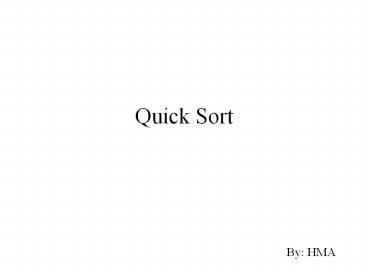Quick Sort - PowerPoint PPT Presentation
Title:
Quick Sort
Description:
Quick Sort By: HMA RECAP: Divide and Conquer Algorithms Divide and Conquer Algorithms Quicksort An element of the array is chosen. We call it the pivot element. – PowerPoint PPT presentation
Number of Views:56
Avg rating:3.0/5.0
Title: Quick Sort
1
Quick Sort
- By HMA
2
RECAP Divide and Conquer Algorithms
- This term refers to recursive problem-solving
strategies in which 2 cases are identified - A case for a direct (non recursive) solution
- A case for a recursive solution containing the
following elements - Dividing the input into smaller problems
- Finding recursive solutions for smaller problems
- Combining the solutions for the smaller problems
3
Divide and Conquer Algorithms
Suppose we want to add the elements in an array
A1N
Add(A array, min, max)
- If min max then return Amin
- If min gt max then return 0
- mid ? floor((minmax)/ 2)
- FirstHalf ? Add(A,min, mid - 1)
- SecondHalf ? Add(A, mid 1,max)
- Return FirstHalf SecondHalf Amid
Complexity O(Dir) O(Div) O(Smaller)
O(Combining)
4
Quicksort
- An element of the array is chosen. We call it the
pivot element. - The array is rearranged such that
- - all the elements smaller than the
pivot are moved before it - - all the elements larger than the
pivot are moved after it - Then Quicksort is called recursively for these
two parts.
5
Example
A 3 8 5 2 7 1 6 4
6
Quicksort - Algorithm
- Quicksort (AL..R)
- if L lt R then
- pivot Partition( AL..R)
- Quicksort (A1..pivot-1)
- Quicksort (Apivot1...R)
7
Partition Algorithm
- Partition (AL..R)
- p ? AL i ? L j ? R 1
- while (i lt j) do
- repeat i ? i 1 until Ai p
- repeat j ? j ? 1 until Aj p
- if (i lt j) then swap(Ai, Aj)
- swap(Aj,AL)
- return j
- Questions
- Why not choose for p the middle position in the
array? - Complexity?
8
Example (again)
A 3 8 5 2 7 1 6 4
9
Complexity Analysis
- Best Case
- Worst Case
- Average case
every partition splits half of the array
T(n) n 2T(n/2) T(1) 1 O(n log2n)
one array is empty one has all elements
T(n) n T(n-1) T(1) 1
O(n2 )
O(n log2n)































